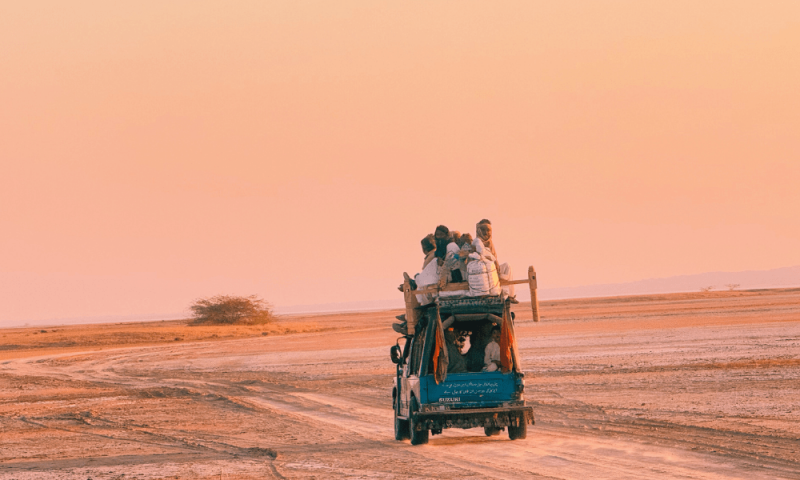If adventure, history, and serenity had a perfect meeting point, it would be here in the Gudroo Rann.
Piyaro Shavani, a 47-year-old local activist and tourism promoter, knows the Gadroo Rann like the back of his hand. He has spent seven nights in this vast, salt-encrusted wilderness — two in November and another five between December and January. And he’s not alone.
“I met two foreign tourists — one from Birmingham, England, and the other from Germany — who spent their entire visit in the Rann,” Shavani shared. “They travelled on camels, soaking in the raw beauty of the landscape and taking pictures.”
In recent months, Thar has quietly been drawing not just domestic visitors but an increasing number of international travellers, eager to witness its splendour.
Unlike other parts of Thar, the Rann remains relatively temperate, thanks to its salt-laden terrain and the water that flows in from across the border in Gujrat, India. This unique ecosystem becomes a haven for migratory birds in winter. “For tourists, it’s a paradise,” he said. “You can see birds of every hue soaring in the sky, and when night falls, the Rann wood makes for the perfect bonfire setting.”
For the past two decades, Thar has been a key tourist hotspot in Sindh, especially during the monsoon months from July to September. Winter, however, was not a peak season for tourists — it belonged to the migratory birds. Every year, thousands of birds escape the harsh cold of their native lands, seeking refuge in Thar’s water-rich landscapes for three months before flying back home.
But this year, something changed.
“We suddenly saw a surge in tourists visiting Thar during winter, not just from different cities of Pakistan but even abroad,” Shavani observed. “Most of them are heading straight for the Rann of Kutch, near the Indian border.”
This salt marsh is approximately 20-25km east of Nagarparkar town and just 7-8km south of the Veera Wah village. Accessibility is not an issue — cars and motorcycles can easily reach the Rann, making it an increasingly popular stop for adventurers.
Several villages dot the landscape around the Rann, but those perched right on its edge — Kharsar, Gidro, Peethpur, Uth Kapario, and Pabasar — offer the closest glimpse into the local way of life. Although this site is part of the larger Rann of Kutch, the locals refer to it as ‘The Rann of Gadroo’, named after the historic village of Gadroo that lies nearby.
“These visitors pitch tents under the starlit sky, riding camel carriages at night, gathering around bonfires, as the soulful tunes of local singers fill the air,” said Shavani.
He added that social media is playing its part in this transformation. As tourists share breathtaking pictures of their adventures online, other travellers from their respective countries feel compelled to explore this landscape. Local photographers, too, are capturing the magic — sunrises and sunsets melting into the horizon, flocks of migratory birds, and camels gliding across the salt flats. These images serve as an irresistible invitation, making the Rann a must-visit winter destination.
Locals bring life to Rann
Dileep Kumar Parmar, a 30-year-old photographer and videographer from Nagarparkar, has played his part in putting the Rann of Gadroo on the tourism map. For the past decade, he has been documenting the beauty of Tharparkar through his page — Karoonjhar Photography — on social media. Now, he has taken his passion a step further by launching Karoonjhar Tourism, focusing on promoting winter tourism in the Rann.
“We actually started Rann winter tourism last year,” Parmar said. “But at that time, we didn’t upload photos or videos on social media because it was a new initiative, and we were still learning the ropes. This year, from November onwards, we started tent camping in Gadroo Rann every weekend.”
As soon as the first batch of camping photos hit social media, the response was overwhelming.
“Tourists began reaching out to us, eager to visit the Rann of Gadroo. By the first week of November, we had visitors arriving, and now we organise weekend tent camps exclusively for tourists,” he says.
Parmar and his team provide a full-fledged camping experience — complete with dinner, BBQ, and traditional Thari breakfast, including bajra roti, yoghurt, omelette, and tea. They also ensure proper hygiene facilities, offering portable commodes, bath tents, and freshwater for washing and drinking.
“Every week, we earn a handsome amount from this,” he revealed, shedding light on how this growing trend is not only attracting visitors but also benefitting the local economy.
The charm of this place is elevated by the villagers who play a crucial role in the tourism experience. Local communities, including the Koli tribe, welcome tourists, offering camel and bull carriages to take them deeper into the Rann or closer to the waters. This group performs their cultural dance and songs, with their iconic “rasooro” echoing through the air. Local singers also serenade tourists with melodious folk songs in the comfort of their tents.
For photographers, videographers, and adventure enthusiasts, Gudroo Rann is a dream come true. The endless white expanse and vibrant culture create the perfect backdrop for an unforgettable experience.
The growing buzz around Gadroo Rann tourism has caught the attention of Sindh’s Minister of Culture, Tourism, and Antiquities Syed Zulfiqar Ali Shah.
“We will encourage tourism in Gudroo Rann by improving facilities and developing new resorts,” he confirmed, adding that “while it already attracts visitors from across the country, we also want to draw international tourists. This will create economic opportunities for local communities, allowing them to benefit directly from tourism.”
“Given the site’s natural beauty and cultural significance, we plan to collaborate with the local government and district administration to launch initiatives that boost tourism. Initially, our focus will be on ensuring essential services such as food, accommodation, and security for visitors,” he stated.
Abid Ali Khaskhali, a 20-year-old from Jam Khan Jo Wandio, a village just 7km west of Gudroo Rann, is among the many locals captivated by this natural wonder.
Sharing his passion for photography, he said: “Three years ago, I filmed the Rann shimmering with water from across the border in Gujrat. That video went viral on social media. This year, our Rann has become a sensation, attracting tourists from across the country and even abroad. Now, I visit daily, capturing stunning sunsets, sunrises, and starry nights.”
However, he requested tourists to respect this pristine land. “Please do not litter — avoid leaving plastic bags, bottles, or waste. The Rann is pollution-free, and we must keep it that way. I urge the government to install large dustbins and construct washrooms for visitors,” he urged.
Shahnawaz Baloch, a 34-year-old lecturer from Hyderabad, recently visited Gudroo Rann with friends and was mesmerised by its beauty. “The Rann of Kutch is one of my favourite places. We recently explored Pabsaro Point, which is a breathtakingly calm area, perfect for stargazing at night. The locals are kind, friendly, and welcoming. Watching migratory birds soar over the Rann’s waters was a surreal experience,” he remarked.
Beyond its stunning landscapes, the region is rooted in history. Tourists can explore ancient Jain temples along the way, delving into the area’s rich archaeological heritage. It is a safe retreat where religious harmony thrives, as many locals belong to the Hindu community.
It’s safe to say that if adventure, history, and serenity had a perfect meeting point, it would be here in the Gudroo Rann.
From its historic sites to its warm and welcoming people, Rann is a marvel waiting to be explored. So pack your bags, bring your camera, and let this surreal landscape leave you spellbound!
- Desk Reporthttps://foresightmags.com/author/admin/











